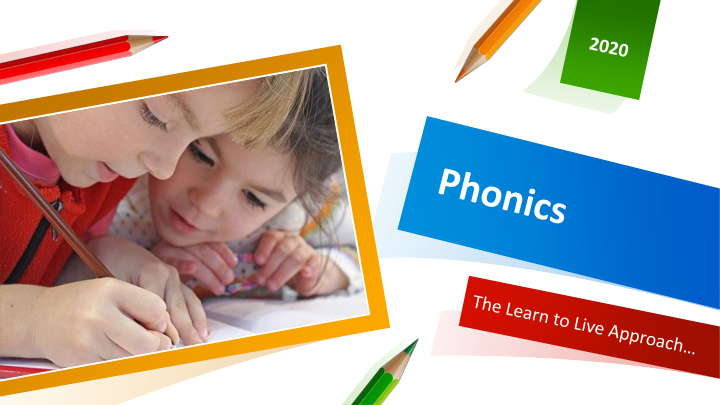



Teaching reading and writing using the letter sounds. We follow the Letters and Sounds order of 2 teaching.
It is a specific order to enable common words to be made easily. Phonic reading books link to this order. The rate of learning new letters and sounds 3 should be child specific.
The sounds that letters make 4
The written representation of the phoneme (sound) – the letter/s 5
Pronunciation matters! ✓ Keep it short ✓ Don’t add an ‘uh’ sound at the end 6
ADD A FOOTER 7
Blending the phonemes (sounds) together to make a word. 8
Breaking a whole word into phonemes (sounds) 9
How many syllables? How many phonemes? 1 2 3 4 5 season on s ea s o n A syllable is a unit of sound powder p ow d er based around a vowel sound. march m ar ch Have a go at syllable rain clapping. chick cken en 10
Words which can not be blended or segmented (coded/decoded) with phonics. For example “the” 11
There are 6 phases in Letters and Sounds which link closely to our Phonics Curriculum 12
❑ Tuning into sounds ❑ Listening and remembering sounds ❑ Auditory memory and sequencing ❑ Talking about sounds ❑ Developing vocabulary and language comprehension 13
ADD A FOOTER 14
• Phase One of Letters and Sounds concentrates on developing children's speaking and listening skills and lays the foundations for the phonic work which starts in Phase 2. The emphasis during Phase 1 is to get children attuned to the sounds around them and ready to begin developing oral blending and segmenting skills. • Children need to have a solid understanding about recognising and making sounds, keeping a beat, understanding speech sounds as well as learning how to talk about the sounds ADD A FOOTER 15 they hear.
• Envir ironm onmen enta tal l sounds ds • Instrum umen enta tal l sounds ds • Body dy pe percussion ssion • Rhyth ythm m and rh d rhyme yme • Allit iter erati tion on • Voic ice e sounds ds • Oral blen endi ding an g and s d seg egmen enti ting ADD A FOOTER 16
• Animal noises • Sound Lotto • Listening walk ADD A FOOTER ADD A FOOTER 17 17
❑ Introduces 19 grapheme-phoneme correspondences (GPC’s) ❑ Decoding and coding taught as a reversible process ❑ Blending and segmenting is introduced ❑ Tricky words ‘the to no go I’ 18
At home ome • Phonics bingo • I-Spy, using phonemes rather than letter names • Flash cards • Orchard games • Reading short words • Spelling short words phonetically • Initial sound pairs 19
❑ Teaches 25 more grapheme-phoneme correspondences (GPC’s) ❑ Focus on writing graphemes (letters) ❑ Continued blending and segmenting practice ❑ Applying skills to reading ❑ Learn to read and spell more tricky words 20
Same as Phase 2 but also including • • Reading phonetically decodable books • Phoneme board games High frequency word recall • • Repeat previous sounds to ensure knowledge is consolidated. 21
❑ Consolidate learning from phases 2 and 3 ❑ No new GPC’s ❑ Develops skills of blending and segmenting words with consonant blends in them e.g. stairs tent brain ❑ Read and spell multi syllabic words e.g. lunchbox and children ❑ Learn more tricky/common exception words 22
Same e as Phase e 2 and d 3 Higher er emp mphas hasis on segmentin enting g and d blend ndin ing games es Increas creased ed reading ding Reading ding words in the environ onmen ent Readi ding ng comprehe mprehens nsio ion n – Un Under erstanding tanding what t they have read and d what t it mean ans 23
❑ Learn different ways of making the same sound e.g. ai, ay, a-e ❑ Alternative pronunciations e.g ow – blow, cow ❑ Choose appropriate graphemes when representing phonemes when reading and writing ❑ Suffixes and prefixes e.g. simply, softly, slowly, unhappy, undone, undress. ❑ Changes in tense e.g run, ran, running 24
❑ sight ❑ site ❑ might ❑ mite ❑ right ❑ write ❑ fright ❑ kite ❑ light ❑ ignite ❑ bright ❑ bite 25
Reading is hard work for all beginner readers, even harder if you have processing, attention, speech and language or visual difficulties. Be patient, kind and positive. Short bursts, keep it enjoyable. Encourage your child to identify and then blend the sounds Read each sentence or encourage them to read the sentence again after they have decoded it to encourage comprehension, fluency and confidence. Give them time to work things out. Explain what words mean if they are not sure. Reduce visual distractions by covering other words or parts of the word if required 26 Reduce auditory distractions – choose a quiet time of day, find the quietest place you can
If they make a mistake give them the opportunity to self correct e.g Was there another sound in that word? Just check that word again, Its okay to use the pictures Remind them if they have seen the word before in the book If your child doesn’t know the graphemes sound then tell them the sound and then encourage them to still do the blending Tell them if it is a tricky word so they don’t attempt to use phonics and then fail Cover up parts of the word to help them Students with processing difficulties could be encouraged to blend as they go e.g catch = c, ca, cat, cat ch, catch – so they are only processing two sounds at any time. 27
Recommend
More recommend